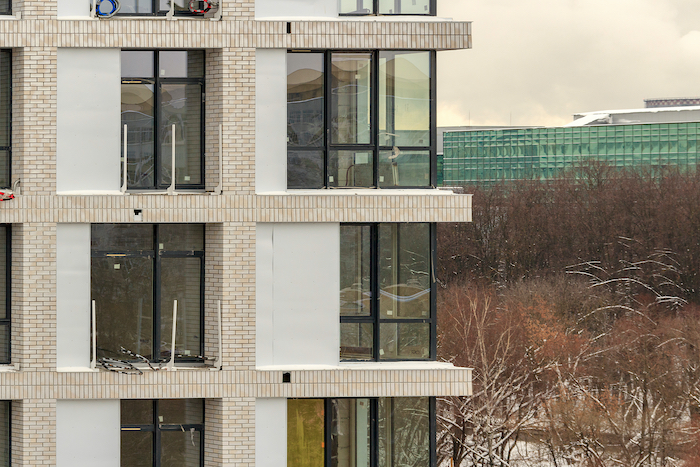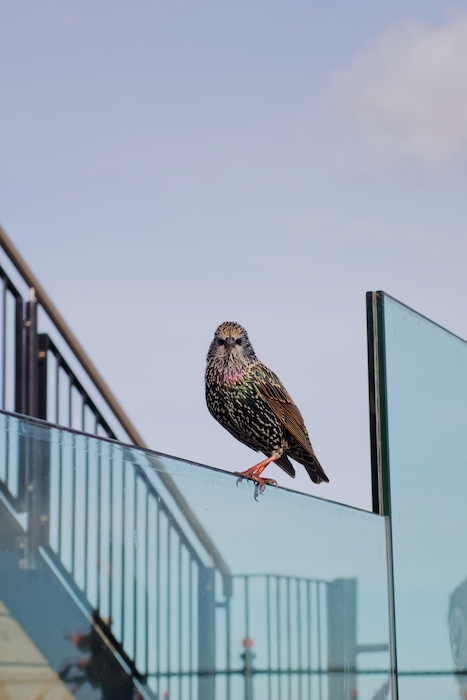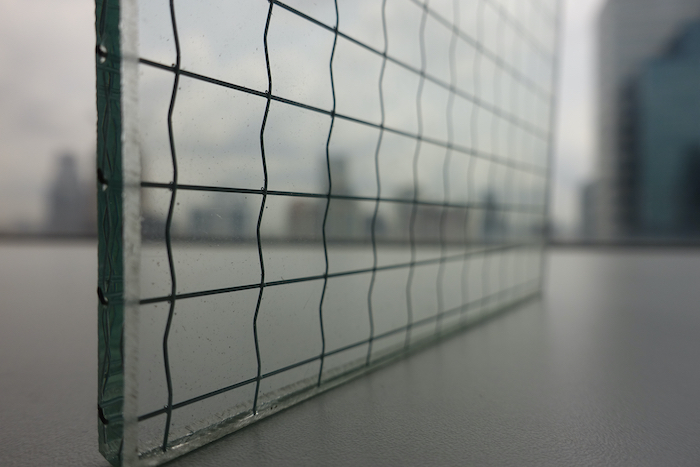
Innovations in glass
April 5, 2023
By Amy Roberts
Types range from bird-friendly to wired and vacuum-insulated.

Calgary Central Library’s unique façade integrates 40% triple-pane insulating glass units (IGUs) with 60% insulating metal panels. For more information on innovations in glass, see story on p. 16. Photo by Michael Grimm Photography, courtesy Vitro Architectural Glass.
Several innovations in the glass industry are adding value to new buildings and retrofits alike, through novel and improved technologies. Glass types continue to evolve, including vacuum insulated glass (VIG), bird-friendly glass and safety glazing. Such innovations can improve sustainability, energy efficiency and injury mitigation.
VIG
With this type, which continues to grow in popularity within the fenestration and glazing industry, a strong vacuum exists between two plates of glass. The gas space slows down conduction, while the vacuum space itself cuts back on it even further.
Bill Davis, a senior insulated glass (IG) technical service and product manager with Vitro Architectural Glass, spoke about VIG at a panel during the Fenestration and Glazing Industry Alliance (FGIA) 2022 Fall Conference. He pointed out VIG is very customizable, which can lead to more benefits in terms of higher R-values, indicating better thermal resistance.
“When you get into dual IGUs,” he explained, “you can add coatings or an exotic gas to improve performance. Triple panes can get you even better performance—you can get up to an R value of R-16.”
Fellow panelist Dave Cooper, chief technology officer (CTO) for VacuumGlass, emphasized the importance of removing barriers for low-cost manufacturing, tempered VIGs and make-to-order supply strategies to better enable a significant market opportunity and adoption. He pointed to retrofits, new commercial construction, new residential windows, ultra-high-end residential replacements, renovations of historic structures and skylights that could all be well-served by VIG.
“With daylighting, we can stop thinking about window-to-wall ratio when we start thinking about VIG,” Cooper said. “VIG supports a greater window-to-wall ratio with significantly enhanced thermal performance.”
However, VIG is not without its challenges. For one thing, despite growing interest and investment, there is still no cost-effective option. Manufacturers may still be conducting today’s research and development (R&D) for tomorrow’s anticipated policies.
Bird-friendly glass
There are both provincial and federal laws in Canada to protect birds. With this in mind, bird-safe design can help building owners avoid legal exposure, whether their structure was originally intended to be bird-friendly or was retrofitted later.
A bird-friendly design reduces the amount of glazed surfaces in a building’s envelope, thus reducing the risk of a bird attempting to fly through it. Considerations like high-thread features, such as clear glass walkways, are also taken into account, as are lighting and opaque features, like grilles or shutters, to deter birds.
Another option is to treat glass with a subtle pattern that is perceptible to birds. Multiple suppliers offer a ‘bird-friendly glass’ featuring these patterns, which might entail lines or dots.
Canadian Standards Association (CSA) A460:19, Bird-friendly building design, addresses such visual elements as acid etchings, ultraviolet (UV) markers, fritted glass, film or non-film adhesive markers. They are designed to be in high contrast to the glazing material.
According to BirdSafe, an organization led by Fatal Light Awareness Program (FLAP) Canada, there are many other benefits to embracing bird-safe architecture, such as incorporating green building best practices and meeting sustainability goals.
The federal government recently announced the certification of 14 new bird-friendly cities in British Columbia, Alberta, Saskatchewan, Ontario, Quebec and Nova Scotia, based on a certification standard developed by Nature Canada. They join Vancouver, Calgary, London, Ont., and Toronto, which were the first cities to be certified, in 2021. The certification encourages municipalities to protect birds from human-caused threats, including but not limited to windows.
Safety glazing
First introduced some 130 years ago, wired glass represented the first attempt at developing ‘safety glass.’ It involved embedding steel wire mesh into annealed glass, while the glass was still soft during processing.
However, while wired glass may appear to be strong, leading many to believe it is indeed safety glass, it typically has only about half the strength of regular plate glass. The wire is a weak link in the glass, such that it may be broken more easily when impacted.
In the mid-1970s, most North American codes and/or standards granted wired glass an exemption from strength requirements. This was because, at the time, it was the only type of glass that slowed the spread of fire and smoke when broken, i.e. by retaining shattered glass within the frame.
Wired glass is not safety glass because it breaks into shards held together by the wires that can snare victims, lacerating, maiming or even killing them. In general, it should not be used where safety glazing is required and where human impact is possible.
In its 2020 edition, the National Building Code of Canada (NBC) began to address this issue by adopting changes that required safety glazing in assembly occupancies to conform to the new safety glass standard, CAN/CGSB 12.1, Safety Glazing. Wired glass does not pass this standard. Instead, to reduce the hazard posed by wired glass, safety glazing is required in windows and doors where human impact is possible in assembly occupancies.
It is important to note that while these code changes eliminate the use of traditional wired glass in areas where safety glazing is required, they do not constitute a complete ban on traditional wired glass, which can still be used in fire-rated window assemblies in locations that are out of reach for most human contact, such as transoms.
Confusion still exists, however, between the terms ‘safety glass’ and ‘fire-rated glass.’ References to “wired safety glass” in both the NBC and the withdrawn standard CAN/CGSB 12.11-M90, for example, should be removed.
And indeed, the Canadian General Standards Board’s (CGSB’s) committee on glass has submitted a code change request to remove these references and to replace them with references to CAN/CGSB 12.1, Safety Glazing, which would apply to all occupancies where glass is subject to potential human impact.
As glass safety has evolved, the need and desire for traditional wired glass have declined and other options have risen to take its place, such as specialty tempered glass, heat-reflective specialty tempered glass and specialty fire-protective glass for door lites or safety ceramics that block radiant heat.
Further, several manufacturers now provide wireless safety glazing products that are fire-rated for 20 to 45 minutes. In essence, fire safety no longer needs to supersede impact safety.
The future of glass is exciting, as these types of products will only continue to evolve and improve with time and testing.
Amy Roberts is director of Canadian and technical glass operations for the Fenestration and Glazing Industry Alliance (FGIA), overseeing the organization’s Canadian standards and regulatory building and energy codes, as well as the Insulating Glass Manufacturers Association of Canada (IGMAC) certification program for insulating glass units (IGUs). She has more than 20 years’ experience in glass manufacturing for both residential and commercial windows. For more information, visit www.fgiaonline.org.
This article originally appeared in the March/April 2023 issue of Canadian Consulting Engineer.


